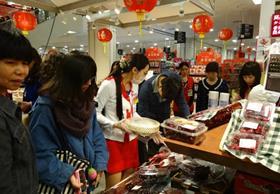
A report from the Australian government has highlighted the growing threat posed by Chile to Australian horticultural exports to the Chinese market.
The Australian Bureau of Agricultural and Resource Economics and Sciences (ABARES) warns in its Agricultural Commodities Report for the 2019 March quarter that large-scale production enables Chile to supply the Chinese market with greater volumes of blueberries, cherries, stonefruit and table grapes than Australia.
“Over the medium term, Australia is expected to face greater competition in China from Chile than from any other Southern Hemisphere suppliers,” the report states.
Chilean fruit exports to China are growing strongly year-on-year. In 2017/18, China imported 358,516 tonnes of Chilean fruit, and increase of 66.4 per cent on the previous year.
“Chilean companies are investing in coldstorage facilities and quality control in China, and have signed agreements with wholesalers to expand their distribution networks,” the report says.
ABARES goes on to say that if the Chilean government is successful in its bid to gain access to the Chinese citrus market this could pose a major threat to Australian exports.
According to Citrus Australia, Chile’s citrus industry has undergone a rapid expansion in the past two decades, which has seen planted area increase by approximately 38 per cent, rising from 13,000ha in 1990 to just over 18,000ha in 2015.
One of the biggest changes has been the surge in mandarin production, which now accounts for roughly one-third of Chile’s planted area. At the same time, orange production has switched focus from Valencia to late Navel.
The dominant soft citrus varieties are clementine and W Murcott mandarins –the latter having been planted in recent years. Production of seedless varieties such as Tango is also on the rise.
Of concern for Australian growers is the push by Chile to gain market access to China.
“While progress on these negotiations has been delayed by other horticultural market access applications within Chile, it is considered likely that Chile will gain market access to China in the next three to five years,” says Citrus Australia.
“It is critical that the Australian citrus industry secures a ‘premium fruit’ position in China, because undoubtedly our product will come under price pressure if we are supplying similar-quality fruit to that available from Chile.”
ABARES concludes that although Chinese economic growth is slowing down, the expected annual growth rate of 6 per cent to 2020 will ensure strong demand for imported foods.



